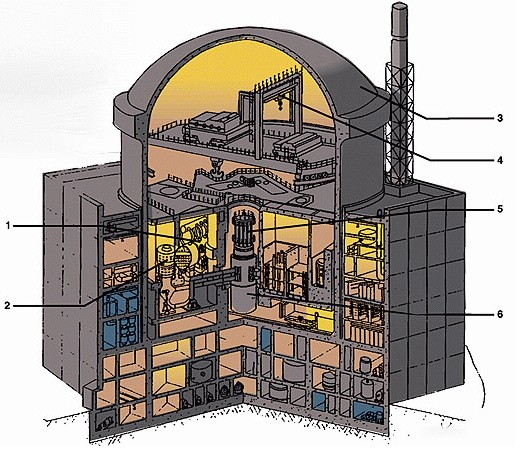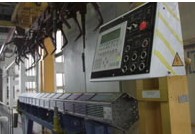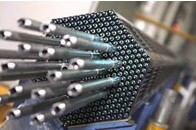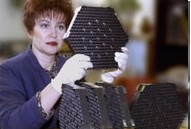Nuclear engineer Behrad Nakhai writes in a guest editorial for Informed Comment
A brief overview of Bushehr nuclear power plant startup (Simplified)
Finally, nuclear fuel loading of Bushehr nuclear power plant started on Saturday 21 August 2010, aided by the Russians. In technology, Russia has always trailed US, although they have somehow been able to keep up with the final products, albeit at inferior levels.
Russia has a less stringent safety standard than the West, particularly US. Under strenuous circumstances, the lower safety standard could elevate minor events to major and serious events. Two serious weaknesses of the relaxed standards are quality control and adherence to the procedures. In US, the procedures are taken very seriously, even though they often seem silly to an untrained individual. It is not uncommon to see “turning the light switch on/off” as part of the procedure. The purpose of such minute details is to leave nothing to chance, memory, or interpretation. Every step MUST be retraceable and documented. Violation of any of the steps can lead to disciplinary and punitive actions, including dismissal. The importance of the procedures cannot be overemphasized. Lack of adherence to the procedures and quality control were the “reasons” for the accident at Chernobyl. Fortunately, the same type of accident cannot occur in VVER–an entirely different design –, although a sever accident can completely damaged the reactor much like the Three Mile Island reactor, but likewise without casualties or causing any damages to the surrounding areas. It should be noted that lack of proper training was the fundamental cause of the accident at Three Mile Island. Fortunately, detailed training and retraining are now mandatory at nuclear power plants in US.
The other weakness in Russian technology is in instrumentation and control. Their systems are not as advanced and fine tuned as those in US. To make up for these deficiencies, either the margins must be increased, which in turn affects the plant efficiency, or safety margin be compromised which affects the plant safety.
The fact that Bushehr’s components come from different vendors is not a cause for concern–components and parts for most US nuclear power plants come from different vendors. However, the fact that these components come from different vendors with different standards and practices is somewhat worrisome. In technology, the whole system is as good as its least dependable component. Nuclear grade manufacturing is quite different from non-nuclear grade manufacturing, you cannot cut corners. One bad actor could lead to serious consequences.
It is encouraging to know that Russian technicians and operators will be co-operating Bushehr plant for at least the first three years. This will give Iran the time to develop and institute a robust training program for Iranian operators and technicians while on the job.
I hope Bushehr is almost the last of the current generation of nuclear reactors–American, European, Japanese, Russian, etc. Currently, the focus is on the third and fourth generation reactors. . These are the advanced “standardized” reactors with several added layers of safety. The 250-400 MWE (Megawatt Electric) unit has the advantage that it can be built at the factory and shipped to the site, where the larger 1000 MWE unit must be built at the site.
I wish that focus would shift to the fifth generation reactors, that not only produce power and generate hydrogen, but also desalinate water. Such plant can help to alleviate a truly human tragedy in the making. By 2025, one third of world population will not have access to safe drinking water. Population increase will only make the condition worse. Nuclear can help in two ways: desalination, and sterilization. See this link.
First, alleviating the fear of diversion
For all practical purposes, the enriched U in the fuel CANNOT be diverted. The fuel is in the form of sintered uranium dioxide ceramic pellets (the pellet is a tad larger than the size of the eraser at the end of a pencil. Each pellet has as much energy as 1 Ton of coal, 126 gallons of oil, or 17,000 cubic feet of natural gas) loaded in Zirconium alloy tubes. 312 of these tubes are loaded in a matrix called fuel assembly. 163 of these assemblies are loaded in the reactor core (#6 in the schematic). In an active core, U235 atoms undergo fission (low energy neutron-U235 collision)—generating 200 Mev energy per atom of U (burning of an atom of Carbon-fossil fuel, generates 4 ev energy). This energy is captured in the form of thermal energy by the flowing water in the fuel channel. For each 100 fissions of U235, around 243 high energy neutrons are released. Some of these high energy neutrons interact with the abundant U238 and convert them into Plutonium—a fissile element not found in nature. Plutonium is the potent and feared “weapon” grade atom. However, in light water reactors (LWR) such as Bushehr, the Plutonium atoms themselves undergo further fission and generate energy. In fact about a third of the cycle energy in LWR comes from fission of the Plutonium atoms. THE only way to retrieve the Plutonium before it undergoes fission is by shutting down the reactor, removing the reactor vessel dome (atop #5 in the figure), removing the fuel assemblies from the reactor (using #4 crane in the figure), removing the very hot and radioactive fuel rods from the fuel assemblies, and transporting the “deadly” radioactive fuel rods to a reprocessing plant, which amounts to a major task involving series of intense and highly visible activities not possible to conceal, particularly from IAEA resident inspectors. Furthermore, the depleted fuel is not of much use for weapon purposes at the end of the cycle either, because the fuel is depleted, hot, and radioactive that should only be moved to the spent fuel tank. It should be noted that even US with all its technological might does not reprocess spent fuel for weapons. Otherwise, all operating and decommissioned civilian nuclear power plants in US would have gladly and patriotically donated their entire spent fuel—which is currently seating in their spent fuel pool at great burden and cost–to the government.
1996: The National Academy of Sciences declares nuclear fuel reprocessing impractical and too costly for the country.
Steps to power production
After the fuel is loaded in the reactor, the reactor dome is installed and the vessel sealed. Reactor startup involves a series of tests. First tests are performed at cold shutdown (zero power – zero criticality) on all components such as pumps, valves, instrumentations, control rods assemblies, etc. This step can take anywhere from couple of weeks to couple of months. At this stage, the fuel has not yet undergone any fission (zero criticality). In the next step the fission process will start, but remains sub-critical for further testing. Depending on test results, this phase too can take between two weeks to two months. If all the tests are successful, the reactor will then be allowed to approach criticality at zero power for zero power testing. If all goes well, at this point the power is allowed to increase and maintained at low power for low power testing. Upon success of these tests, the reactor power is allowed to ascend to 100%, and the brakers activated to connect the plant to the nation’s power grid. On Saturday, the first step of many steps will be taken. I wish Guinness World Records had been invited for the occasion to witness the 35 years record, indeed a very rare record. Iran will retain the record for the foreseeable future, and most probably for the entire era of nuclear power plants.
VVER 1000 (Bushehr may be different in some details)
VVER-1000 Reactor

Legend: 1.Horizontal steam generator, 2.Reactor coolant pump, 3.Containment building, 4. Refueling crane, 5.Control rod assemblies, 6.Reactor vessel.

Nuclear fuel for VVER-1000 reactors is manufactured and delivered in the form of fuel assemblies designed for generation and transfer of thermal energy to the coolant flow (water) in VVER-1000 reactor core. The core of VVER-1000 reactor is loaded with 163 fuel assemblies, which remain fixed during in-pile operation. Nuclear reaction, reactor power maintenance and transition from one power level to another one are controlled via vertical movement of rod control cluster assemblies in the reactor core.
A Rod Control Cluster Assembly (RCCA) consists of 18 absorber rods.
In 1997 OAO MSZ commenced on the work related to the development and implementation of alternative VVER-1000 fuel assembly design, the fabrication of those assemblies started in 1998.
Compared to the standard VVER-1000 fuel assembly, the alternative VVER-1000 fuel assembly is characterized by an improved bundle design implemented via the application of stiffening angles. This fuel assembly offers the intermediate option between shroud-less fuel assemblies and those with shroud tubes.
An alternative VVER-1000 fuel assembly is composed of three main interconnected components, namely: top nozzle, central piece and bottom nozzle.
Top nozzle is designed for coupling the fuel assembly with refueling mechanisms during FA loading and unloading. Bottom nozzle provides for the FA placement in the reactor as well as for the coolant circulation to cool down fuel rods.
The fuel bundle contained between top and bottom nozzles consists of fuel rods (U-Gd rods) and guide thimbles interconnected by means of spacer grids and support lattices. To enhance design rigidity and reduce fuel assembly bow during operation spacer grids and top nozzle with the support plate are interconnected through angle sections making a single whole skeleton.
Alternative VVER-1000 fuel assemblies are characterized by geometric stability at high fuel burn-ups and assure nuclear safety and high performance indicators of VVER-1000 cores with high burn-up level and fuel cycles of 4×1, 5×1, 3×1,5 years.
Fuel rods are cladding tubes made of zirconium alloy and filled with sintered uranium dioxide pellets (U-rods) or UO2 +Gd2O3 pellets (U-Gd rods) sealed with end-plugs by means of welding. Application of U-Gd rods allows to improve power density distribution along the fuel assembly and enhance core safety.
Fuel rods are manufactured in automated lines equipped with state-of-the art control and inspection devices guaranteeing high quality and safety of the manufactured product.
- Key technical characteristics
| Characteristics of the core and alternative VVER-1000 fuel assembly | ||
| Fuel cycle (number of cycles, cycle length in years) | 4×1 | 5×1 |
| Reactor thermal power, MW | 3200 | 3200 |
| Number of fuel assemblies in the core, pcs. | 163 | 163 |
| Total uranium weight in the core, t | 71 | 71 |
| Number of annually replaced fuel assemblies, pcs. | 42 | 33 |
| Average enrichment of make-up fuel, % | 4,4 | 4.8 |
| Average discharge fuel burn-up, MW d/rgU | 47 | 58 |
| Water temperature at reactor inlet, "? | 290 | 290 |
| Water temperature at reactor outlet, °? | 320 | 320 |
| Water pressure in the reactor, MPa (kgf/cm2) | 15,7(159) | 15,7(159) |
| Overall assembly length, mm | 4570 | 4570 |
| Overall fuel assembly width | 234 | 234 |
| Total fuel assembly weight, kg | 710 | 710 |
| Nominal uranium weight in the fuel assembly, kg | 435 | 435 |
| Number of fuel rods in the FA, pcs. | 306 | 303 |
| Number of gadolinium fuel rods in the FA, pcs. | 6 | 9 |
| Uranium enrichment depending on design modification, % | 3,3-4.4 | 3,3-5,0 |






 © 2024 All Rights Reserved
© 2024 All Rights Reserved